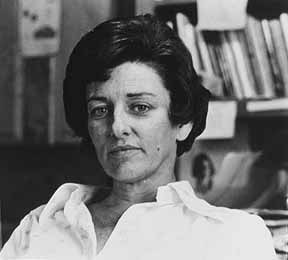The Starry Night by Anne Sexton
“The Starry Night” is about how a depressed speaker interprets another kin’s artistic representation of the nocturnal sky. This poem is an ekphrasis of the Dutch Post-Impressionist painter Vincent van Gogh’s magnum opus by the same title, The Starry Night. It is an oil on canvas painting that Gogh drew in his asylum room at Saint-Rémy-de-Provence in June 1889. Through this piece, Sexton draws her readers’ attention to the painting and talks about its impression on her mind. Her preoccupation with death gets reflected in each verse.
- Read the full text of “The Starry Night” below:
The Starry Night by Anne Sexton That does not keep me from having a terrible need of—shall I say the word—religion. Then I go out at night to paint the stars.Vincent Van Gogh in a letter to his brother The town does not exist except where one black-haired tree slips up like a drowned woman into the hot sky. The town is silent. The night boils with eleven stars. Oh starry starry night! This is how I want to die. It moves. They are all alive. Even the moon bulges in its orange irons to push children, like a god, from its eye. The old unseen serpent swallows up the stars. Oh starry starry night! This is how I want to die: into that rushing beast of the night, sucked up by that great dragon, to split from my life with no flag, no belly, no cry. - from All My Pretty Ones (1962)
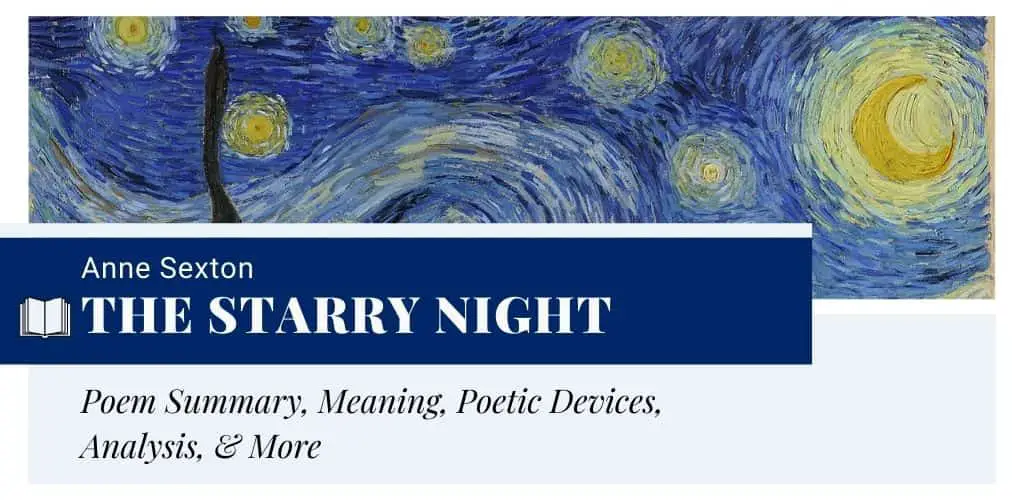
Summary
“The Starry Night” begins with an allusion to Vincent van Gogh’s letter to his brother where he states that his love for art does not keep him away from “religion”. In order to explore the divinity, he goes out at night and paints the stars.
In the first stanza of the poem, Sexton’s persona talks about her mental impression of the painting. She describes that the town in the picture does not exist except for the woman’s black hairs waving upwards as if she is drowning in the starlit sky. The town remains silent and the night boils down with “eleven stars”. In the painting, there are ten stars. Did Sexton mistakenly count “venus” as a star? This starry night makes her so fascinated that she wishes to die under such a glorious sky.
In the second stanza, she describes the stars and how they move like living creatures. Even the moon seems to bulge its orange hue out to push children away from its sight. The old serpent, mingled in the colors, seems to be swallowing up the stars. The speaker again repeats her intention of dying after imagining the image in her mind.
In the third stanza, she wishes to be swallowed by this “rushing beast of the night”. She can get relief of her worldly pains when the “great dragon” sucks her, leaving no trace of her body. She doesn’t even want anybody to hear her last cry.
Meaning
To understand the meaning of Sexton’s “The Starry Night”, one has to look at Gogh’s painting. Then, it would be easy to determine whether there is a similarity or the poet’s imagination starkly contrasts with Gogh’s idea.
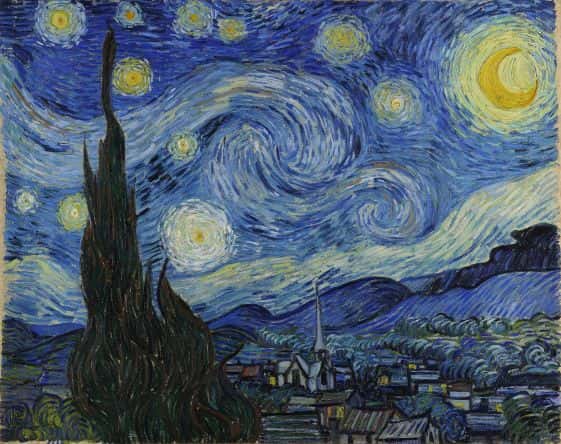
After looking at this painting, it does not seem that the artist is preoccupied with death. He might be mentally disturbed. But, he is not hateful towards life or nature. He rather appreciates the nocturnal beauty of the sky in somber and contrasting colors. She contrasts death with life. His focus mostly lies in the mobility and vibrancy of the stars, rather than in the stillness and monotony of the town represented in the picture.
In Sexton’s poem, the speaker is preoccupied with death. She has an appreciation for art. In his poem “Ode to a Nightingale”, John Keats wishes to die after listening to the intoxicating song of the nightingale. Like Keats, Sexton thinks that death can liberate her from her sufferings. Interestingly, this approach to decoding the meaning of the poem informs readers that the interpretation depends on the dominant urge existing in one’s mind. In Sexton’s case, it is death.
Structure, Form, & Rhyming
“The Starry Night” is a free-verse poem. It is told from the perspective of a first-person speaker. The poetic persona describes how she interprets Gogh’s painting. Besides, she also hints at her suicidal thoughts in the text. Thus, it is an example of confessional poetry as well as a free-verse lyric.
Structurally, there are a total of three stanzas. The first two points at different aspects of the painting. The third stanza is an elongation of the idea present in the second stanza. In the first two stanzas, there are six lines each. The last stanza contains five lines.
Sexton uses a few slant rhymes in the text. For example, in the first stanza, “slips” imperfectly rhymes with “stars”. In the last one, “belly” and “cry” rhyme imperfectly.
Poetic Devices & Figurative Language
“The Starry Night” contains the following poetic devices:
Enjambment
Where does it occur?
- Lines 1-3
- Lines 5-6
- Lines 8-9
- Lines 11-17
Sexton internally connects the lines in order to make readers read the consecutive lines. After reading the enjambed lines in one go they can grasp the idea of the poet. For example, the second stanza and third stanza are connected. The last line “I want to die:” of the second stanza is connected with the ideas of the third stanza.
Allusion
Through the title and the epigraph of the poem, Sexton alludes to Vincent van Gogh’s masterpiece The Starry Night. She illustrates specific elements from that piece in order to highlight their influence on her mind.
Simile
Where does it occur?
- Lines 2-3: The cypress tree is compared to a “drowned woman”.
- Lines 8-9: The moon is compared to a “god”.
Metaphor
Sexton uses the following metaphors in the poem.
- “black-haired tree”: It is a personal metaphor. Here, the cypress tree is compared to a “black-haired” woman who died from drowning.
- “The night boils with eleven stars”: Here, the night is compared to a liquid that is boiling due to the presence of bright stars.
- “Even the moon bulges in its orange irons”: The moon’s hue is compared to the orange color of hot iron.
- “The old unseen serpent”: The swirling wave coming from the left to the center of the picture is compared to a serpent.
- “rushing beast of the night” & “that great dragon”: It is further compared to a beast rushing on the sky and part of a dragon’s tail.
Personification
It occurs in lines 2-3 of the first stanza. Here, the cypress tree is personified. In the second stanza, the poet personifies the stars by the line “They are all alive.” In the following line, she invests the moon with the idea of pushing children away from its sight.
Metonymy
The phrase “hot sky” refers to the effect of the stars. Using this phrase, Sexton is actually hinting at the starlit sky.
In the fourth line, the speaker says, “The town is silent”. Here, the word “town” is a metonym for the people living there. So, the town is not silent. The dwellers of that town are silent as the painting depicts the hour just before dawn.
Alliteration
The repetition of similar sounds in neighboring words can be found in the following examples from the text.
- “exists/ except” (Assonance)
- “starry starry” (Consonance)
- “orange irons” (Consonance)
- “serpent swallows” (Sibilance)
Other Poetic Devices
- Refrain: In the first two stanzas, the lines “Oh starry starry night! This is how/ I want to die” are used as a refrain. This repetition highlights the poet’s preoccupation with death.
- Rhetorical Exclamation: Sexton uses a rhetorical exclamation (“Oh starry starry night!”) as part of the refrain.
- Anaphora: It occurs in the last two lines. Both lines begin with the term “no”.
- Insinuation: By these lines “to split/ from my life”, Sexton is insinuating death or suicide.
- Repetition: In the first stanza, there is a repetition of the phrase “The town” in the first and fourth lines. Sexton repeats a sequence of terms beginning with “no”. These repetitions are used for achieving an artistic effect.
- Palilogy: It occurs in “Oh starry starry night!” Here, the term “starry” is repeated for the sake of emphasis.
Line-by-Line Analysis & Explanation
Before reading the analysis of “The Starry Night,” let’s listen to Anne Sexton reading her poem. It will give readers a better idea of the tone and mood of the speaker.
Epigraph
That does not keep me from having a terrible need of—shall I say the word—religion. Then I go out at night to paint the stars. Vincent Van Gogh in a letter to his brother
The epigraph to the poem “The Starry Night” gives a clear hint to the main idea. Sexton quotes a fragment from one of Vincent van Gogh’s letters to his brother. Gogh wrote to his brother often about his paintings, their motifs, and any questions arising from a particular idea. In this quote, he talks about the role religion plays in his life.
Gogh ironically remarks that he is never in a “terrible need” of “religion”. When does a person in such a “terrible need”? It is clearly the time when a person undergoes mental breakdown, trauma, or heartache. Then religion plays its role as a healer. But, what does religion mean to Gogh?
In the next line, he talks about going out at night to paint the stars. Does painting act as a form of religious vocation for the speaker? Albeit, an artist worships the divine through the medium of art. For Gogh, the painting acts as a mode to communicate with the divine.
The Letter of Vincent van Gogh
Van Gogh wrote this letter to his brother Theo van Gogh on Saturday, 29 September 1888. In this letter, he sent the sketch of Starry Night Over the Rhône. At the time of writing this letter, Gogh was disillusioned by religion but had not lost his belief in an afterlife. He voiced his ambivalence in this letter to Theo.
Let’s have a look at a few lines from Gogh’s letter that describe his stance on religion, God, and spirituality.
This Benedictine priest must have been very interesting. What, in his opinion, is the religion of the future likely to be? He’ll probably say, still the same as the past. Victor Hugo says, God is a lighthouse whose beam flashes on and off, and so now, of course, we’re passing through that darkness.
My only wish is that they could manage to prove something that would be calming to us, that would console us so that we’d cease to feel guilty or unhappy, and that just as we are we could proceed without getting lost in loneliness or nothingness, and without having at each step to fear or nervously calculate the harm which, without wishing to, we might cause others.
Source: http://www.vangoghletters.org/vg/letters/let691/letter.html
Lines 1-3
The town does not exist
except where one black-haired tree slips
up like a drowned woman into the hot sky.
The first stanza of Sexton’s poem “The Starry Night” depicts the painting of Van Gogh. Sexton’s persona does not appreciate the painting as a whole. She talks about each component of the piece. For example, the first line is about the town. According to the speaker, the town is purely a work of imagination. But, in the painting, the town is there. There are several houses and amidst the town stands a church. Its pointed tower is in parallel with the cypress.
The Town: Imaginary or Real?
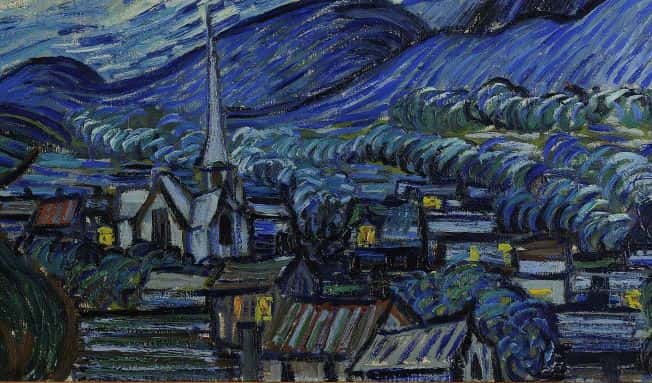
There is no such town that can be visible from the window of the asylum bedroom where Gogh painted the picture. The village has been identified as a recollection of Gogh’s Dutch homeland or a sketch of the town of Saint-Rémy.
The Cypress Tree: a “black-haired” woman?
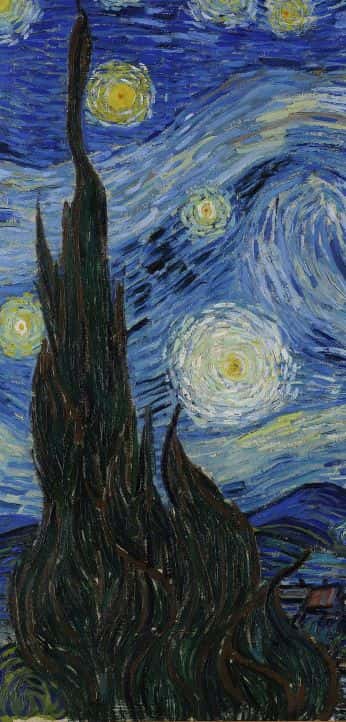
In the following lines, there is a reference to the cypress tree, described as the black hairs of a drowned woman. She sees the sky as a sea where the woman drowned. This image tells readers that the thoughts of suicide were imminent in Sexton’s mind. She wrote this piece at a time when she was undergoing a mental breakdown. Through this reference, she reveals her suicidal intent.
The “hot sky”
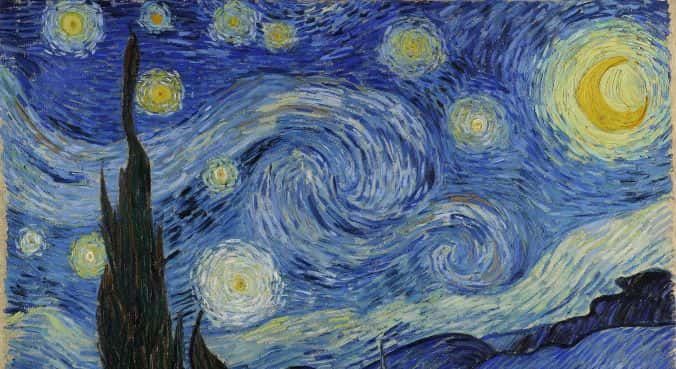
The sky appears to her as a hot liquid. It is boiling due to the presence of “hot” stars. So, the phrase “hot sky” means that the stars heat up the sky. This image alludes to a punishment in hell where a vicious soul is said to be punished by drowning it in a hot, boiling liquid.
Lines 4-6
The town is silent. The night boils with eleven stars.
Oh starry starry night! This is how
I want to die.
In Gogh’s painting, the town is silent as at night people generally sleep. The yellow light of the fireplace gets reflected in the windows of some houses. While the night “boils” as if it is liquid. In the previous line, the “sky” is compared to a liquid. Now, the “night” is metaphorically described as a boiling liquid. The heat of the stars causes it to boil.
Eleven Stars or Ten? (Let’s see …)

Sexton talks about “eleven stars”. But, in the painting, there are ten stars alongside the venus and moon. As readers know, Venus is referred to as the “morning star”. The poet counts it among the stars.
The Venus
The brightest star in the painting, right of the cypress tree, is Venus. Researchers have determined that the “morning star” was visible at dawn in the spring of 1889 when Gogh painted this piece.
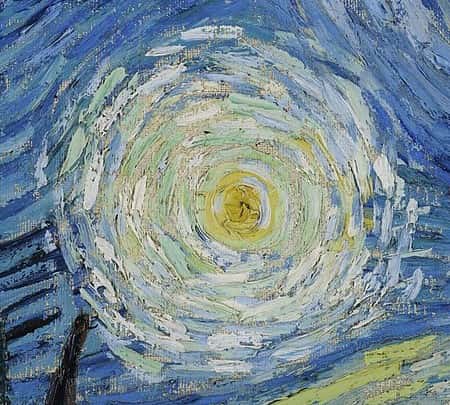
The last two lines of the first stanza act as a refrain. Here, Sexton expresses her amazement regarding the starry night. The sky boils down with the heat of the stars. She wants to be assimilated in the night sky in a similar manner. The last line of this stanza makes it clear that the painting fuels her suicidal thoughts. Only death can give similar satisfaction as the art produces in her mind.
Lines 7-9
It moves. They are all alive.
Even the moon bulges in its orange irons
to push children, like a god, from its eye.
The use of end-stopped lines is present throughout the poem. For example, the second stanza (Line 7) begins with two end-stopped lines. The ideas are cut short. It seems as if the speaker is immersed in her thoughts and she utters one or two short lines between her thought process.
She depicts the stars as moving circularly as if they are alive. According to her, even the moon is not lifeless. It bulges in its orangish hue. Sexton symbolizes this color as a sign of fear. It makes children hide their eyes and pushes them away as if it is as powerful as a god. The image of “orange irons” is used to convey the moon’s warm color.
The Waning Moon

In Gogh’s The Starry Night, the Moon is the waning crescent. As per astronomical records, at the time Van Gogh painted the picture the moon was waning gibbous. While some others interpreted his Moon using biblical references. For them, it revealed an apocalyptic theme.
Lines 10-12
The old unseen serpent swallows up the stars.
Oh starry starry night! This is how
I want to die:
The Expressionist Swirls
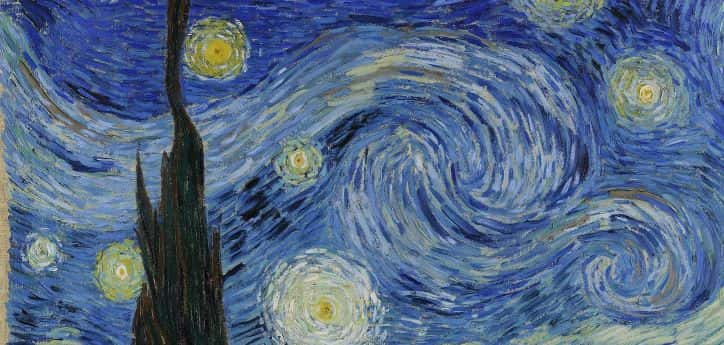
In his letter (20 November 1889) to Émile Bernard, Van Gogh writes,
I don’t say one might not try one’s hand at it after a whole life long of experimentation, of hand-to-hand struggle with nature, but personally, I don’t want to trouble my head with such things. All year I was doing little things after nature, without giving a thought to impressionism or whatever else. And yet, once again I allowed myself to be led astray into reaching for stars that are too big – another failure – and I have had my fill of that.
Source: http://www.webexhibits.org/vangogh/letter/20/B21.htm
Here, he is referring to the expressionistic swirls present in the upper center portion of the painting.
According to art scholars, the swirling figure at the center is either a spiral galaxy or a comet. Some interpret it as Gogh’s representation of the cosmos as a dynamic place. While others see it as a non-realistic element of the painting along with the town.
The Swirls: an “unseen serpent”?
In line 10, Sexton describes the swirls in The Starry Night as an ancient creature representing a serpent. It swallows up the stars one by one. What she thinks deals with the impression of the picture on her mind. The painting is static but the further imaginings are purely the work of an onlooker’s mind.
According to Sexton, the swirls are nothing but part of an ancient serpent that lives in the sea-like sky. In mythological stories, the sea is the home of such creatures. So, here Sexton depicts the sky as a sea.
The second stanza ends similarly with the refrain. There is only one difference. The last line’s idea is further elaborated in the third stanza. Hence, it ends with a colon.
Lines 13-14
into that rushing beast of the night,
sucked up by that great dragon, to split
The third stanza is enjambed to point at the important idea of the text. Sexton points at the swirls again and compares them to a beast. It rushes across the sky in order to gulp the stars or whatever coming across its path. It seems like the poet is talking about a black hole. Like the event horizon, nothing can flee away after getting close to it. The poetic persona wants to get sucked up by this creature. Thus, there will not be any remnants of her body behind.
The “great dragon”
Furthermore, she compares the swirls with a “great dragon”. It seems Sexton is alluding to the noted art historian Meyer Schapiro’s interpretation of The Starry Night. In his book Vincent van Gogh, Schapiro says that the swirls refer to the New Testament book of Revelation. According to him, the “hidden content” of the work reveals an “apocalyptic theme of the woman in pain of birth, girded with the sun and moon and crowned with stars, whose newborn child is threatened by the dragon.” Sexton is probably referencing this “dragon”.
Lines 15-17
from my life with no flag,
no belly,
no cry.
In the last few lines of the poem, the poetic persona confesses her wish to leave her earthly burden (her body). When this creature sucks her up, it would cut the connection between her and her family within a flash of a second. Nobody can find her whereabouts, even the remnants of her body.
The term “no flag” is a reference to the sign of her body. In the last two lines, she uses the same pattern to present the terms: “belly” and “cry”. These terms are associated with the idea of crying, referencing the pain of death. So, the speaker somehow is afraid of the pain of ending her own life. Hence, she wishes to end her life all of a sudden by offering herself to that “great dragon”. Everything will happen so swiftly that she cannot even feel any pain.
Themes
Sexton’s poem “The Starry Night” explores the themes of impression and interpretation of art, death, and suicidal thoughts, and satisfaction versus pain.
Impression and Interpretation of Art
The main theme of this piece concerns art and the impression it creates on one’s mind. It depends on the mental state of a viewer regarding how he interprets art. In Sexton’s case, the fusion of divinity and realism appears to her as a manifestation of death. The nocturnal view of the cypress tree occurs to her as a lady who has drowned. In this way, the interpretation of art varies from person to person.
Death and Suicidal Thoughts
The next theme that captures readers’ attention is the speaker’s preoccupation with death and suicidal thoughts. She presents the picture from the perspective of a mentally broken person. The art makes her so intoxicated that she imagines her suicidal impulse as a way to liberate her soul from the sufferings as art does.
Satisfaction vs. Pain
The last stanza specifically points to the theme of satisfaction and pain. Sexton’s speaker wants to be satisfied through death. In order to do so, she has to kill herself. But, the process is painstaking. Hence, she wants to be sucked up by the whirlpool, shown as a “great dragon”.
Imagery
Sexton uses the following types of imagery in “The Starry Night”:
- Visual Imagery: This poem is centered on visual art. In each section, Sexton captures a component from Gogh’s painting and expresses her imagination regarding it. For example, in the first stanza, she depicts the image of the town, cypress tree, and the sky.
- Kinesthetic Imagery: She uses kinetic imagery in “where one black-haired tree slips/ up like a drowned woman”. Here, the act of slipping up is portrayed. This imagery is also present in “that rushing beast of the night”. Here, the swirls in the painting are depicted as rushing through the sky.
- Organic Imagery: Through the refrain, the poet conveys her internal emotion concerning dying to the readers. In the last three lines, she evokes the idea of dying by splitting her life into parts.
Historical Background
One of the best poems of Anne Sexton, “The Starry Night” was first published in her poetry collection All My Pretty Ones. It was published in 1962. Sexton suffered from severe bipolar disorder, a mood disorder characterized by periods of depression and periods of abnormally elevated mood lasting from days to weeks each. Her first manic episode took place in 1954 and later she was diagnosed. Her psychologist encouraged her to write poetry in order to get relief from her mental pain.
In the case of Dutch painter Vincent van Gogh, he suffered from psychotic episodes and delusions. He often neglected his health for being worried about his deteriorating mental stability. In 1889, he stayed at Saint-Rémy-de-Provence asylum. During his stay at this asylum, he produced some of his best-known works including The Starry Night. He created this piece around 18 June.
About 20 September 1889, he mentioned the painting in a letter to Theo, referring to it as a “night study”. He wrote:
All in all the only things I consider a little good in it are the Wheatfield, the Mountain, the Orchard, the Olive trees with the blue hills and the Portrait and the Entrance to the quarry, and the rest says nothing to me, because it lacks personal will, feeling in the lines. Where these lines are close together and deliberate the painting begins, even if it may be exaggerated.
Source: http://www.vangoghletters.org/vg/letters/let805/letter.html#translation
In a letter to painter Émile Bernard from late November that year, he referred to The Starry Night as a “failure”.
Whatsoever, both Sexton and Van Gogh had similar manic episodes. Sexton could relate her suffering to Gogh’s. She might have discovered his unseen, sad core in his painting. Thus, she felt the same while interpreting it.
Questions and Answers
The Dutch Post-Impressionist painter Vincent van Gogh created The Starry Night in June 1889 while he was in his asylum room at Saint-Rémy-de-Provence. The painting depicts the sky just before sunrise. It is not a realistic representation of the night sky. Rather it shows the mental impression the sky had on Gogh’s mind. Besides, it shows the intricacies of his creative mind and his tortured soul. The more one looks at it the more he becomes encapsulated in this impressionist sky of Gogh’s. For this reason, this piece is so special.
One of the best poems of Anne Sexton, “The Starry Night” is undoubtedly appropriate to the painting. The poetic persona conveys Gogh’s message implicit in the colors and motifs. After looking at the starlit sky, she thinks of nothing other than death. The components collectively make her think that she can relieve her soul by being immersed in the painting, symbolically portraying death.
Sexton emphasizes the town, cypress tree, stars, Venus, Moon, and the swirls from Van Gogh’s Starry Night.
Anne Sexton wrote this poem probably when she was undergoing a mental breakdown. She penned most of her poems in the 1960s. “The Starry Night” was published in All My Pretty Ones in 1962.
Sexton might have connected her suffering with that of Van Gogh’s. After looking at his Starry Night, she found the implicit elements of death and suffering. Through painting, Van Gogh liberated his soul from sufferings. Likewise, through writing this poem, Sexton expressed her deep emotions revolving around death. The painting inspired her to explore those emotions.
“The Starry Night” is a free-verse lyric poem that is written from the perspective of a first-person speaker. It is written in the confessional scheme.
The speaker of this poem is the poet Anne Sexton. She describes what each component of Van Gogh’s painting means to her.
The poem symbolizes the night sky as a sea and the stars moving across the sky as living creatures. Besides, the swirls in the sky are symbolized as part of an ancient sea creature.
The tone of this poem is thought-provoking, relaxing, and peaceful. Throughout the poem, Sexton appreciates the painting in a cold and peaceful tone.
The swirls at the center portion of the painting are depicted as an “old unseen serpent”.
Sexton describes the sky as a hot liquid that boils due to the presence of the stars. The use of contrasting colors makes her think so.
Sexton describes the night as a liquid that is boiling due to the presence of stars. Alongside that, she depicts the starlit sky using rhetorical exclamation. From the use of her poetic language, it can be inferred that the night sky has an intoxicating and awe-inspiring impact on her mind.
In a letter to his brother Theo, Van Gogh made this statement. It was written on 29 September 1888.
Similar Poems about Depression
- “Death of a Young Son by Drowning” by Margaret Atwood – This poem captures a mother’s mental state after losing her only son.
- “To fight aloud, is very brave –” by Emily Dickinson – It’s about the individual struggles and hardships that people often have to deal with in life.
- “Spring” by Edna St. Vincent Millay – It’s about the coming of April and how it makes people forget their harsh realities.
- “I’m “wife” — I’ve finished that” — by Emily Dickinson – It’s about the conflicts inside a woman’s mind.
External Resources
- About The Starry Night — Read this in-depth study of van Gogh’s painting, featuring its emotional and artistic aspects.
- Astrophysicist Janna Levin on van Gogh’s Starry Night — In this episode, Janna Levin brings her celestial expertise to decode van Gogh’s star-filled vision.
- About Vincent van Gogh — Read more about the life and works of the “misunderstood genius,” van Gogh.
- About Anne Sexton — Learn more about the poet and explore her other poems.
- A Brief Guide to Confessional Poetry — Refer to this guide in order to find the elements of confessionalism present in Sexton’s “The Starry Night”.

